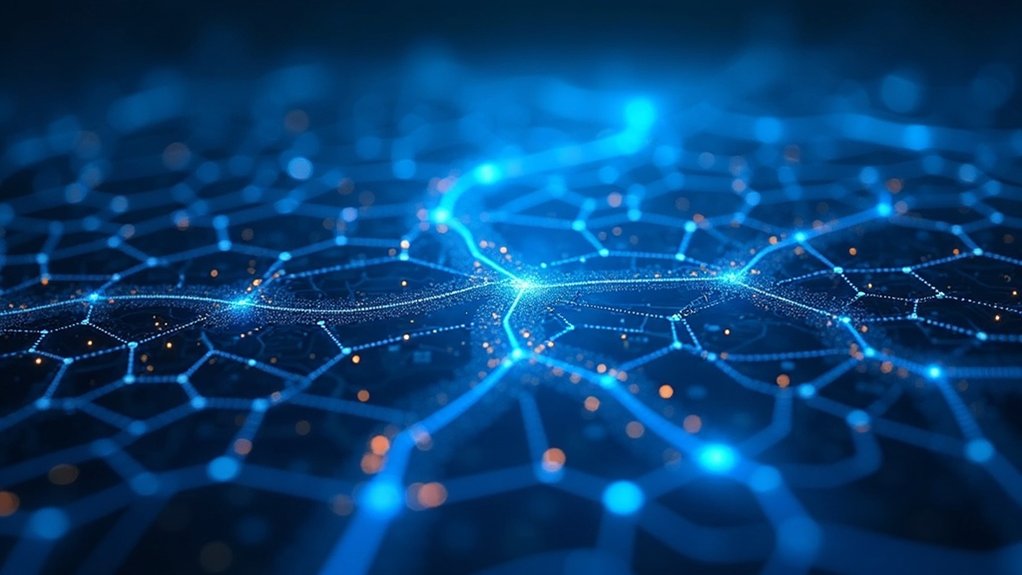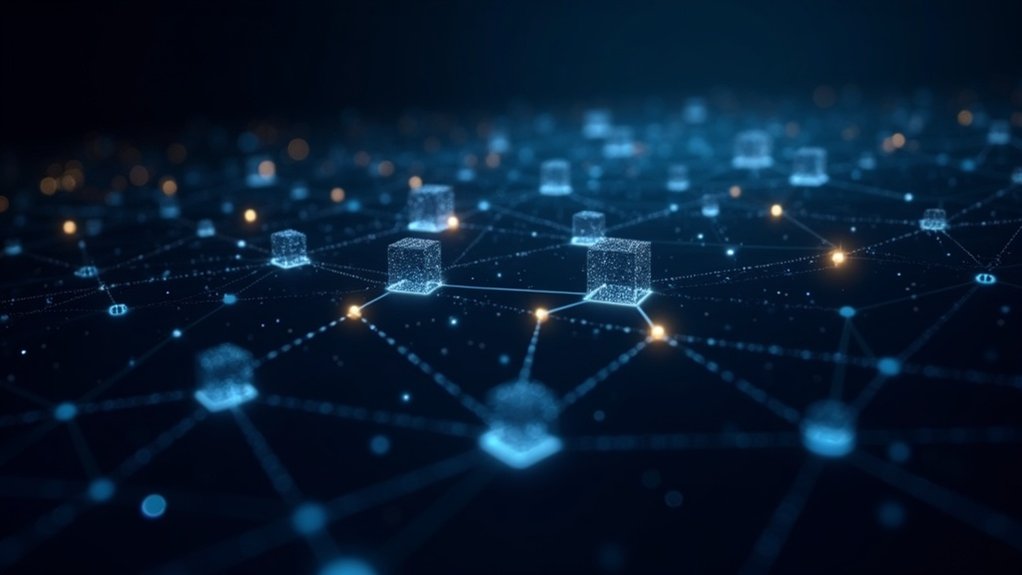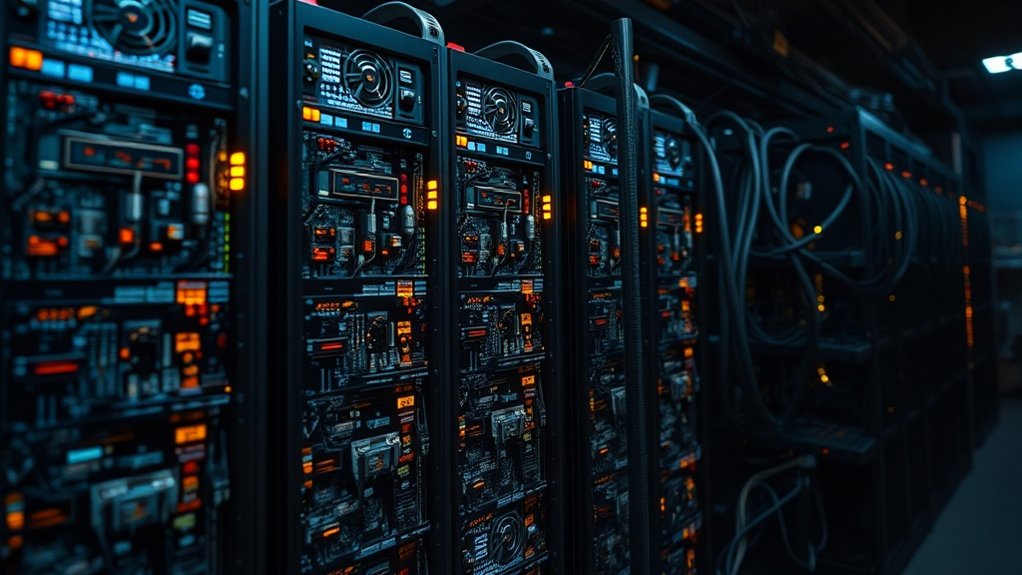Proof of Work underpins blockchain security through computational puzzles requiring serious processing power. Miners race to solve complex math problems using hash functions, with winners adding new blocks and earning cryptocurrency rewards. The system demands enormous energy but creates immutable records—altering past blocks would require more computing power than the entire network combined. It’s been keeping networks honest since 2009, no middlemen needed. The computational cost isn’t just high—it’s the whole point.
The backbone of Bitcoin and many other cryptocurrencies isn’t some fancy marketing or clever logo—it’s math.
Specifically, it’s a consensus mechanism called Proof of Work (PoW), which creates decentralized trust by removing the need for middlemen. Nobody’s in charge. Nobody needs to be. The system maintains itself through computational heavy lifting.
Here’s how it works. Miners compete to solve complex mathematical puzzles based on hash functions. Think digital treasure hunt, but with supercomputers instead of shovels.
Miners race to crack cryptographic riddles—a high-stakes mathematical competition where computing power replaces luck.
These puzzles aren’t just difficult for fun—their difficulty adjusts automatically every couple of weeks to keep validation times consistent. Bitcoin targets about 10 minutes per block. Not 9. Not 11. Ten.
The winner? Whoever solves the puzzle first broadcasts their solution to everyone else. Other nodes quickly check it (verification is easy, solving is hard—that’s the point), and if valid, the block gets added to every copy of the blockchain. No take-backs. Selected transactions from the mempool are bundled into new blocks during this process.
This computational effort isn’t free. Miners burn through electricity like teenagers through pizza. But there’s a reward: native cryptocurrency tokens. New coins plus transaction fees. Ka-ching. This carrot-on-a-stick approach keeps miners honest and the network secure.
The beauty of PoW is in its security design. Want to hack the system? Good luck.
You’d need to redo all the computational work for the block you’re trying to alter PLUS every block that came after it. And you’d need to do it faster than everyone else combined. The cost would be astronomical. Math doesn’t care about your hacking skills.
First conceived in 1993 for fighting spam and formalized by Nakamoto in 2008, PoW transformed how we think about trust. The Bitcoin network particularly employs the SHA-256 cryptographic protocol for its mining operations. The system creates consensus through something tangible—computational effort that can’t be faked. It’s immutable. Decentralized. Secure. This technology has been remarkably resilient, operating for over a decade without any significant security breaches or compromises.
No central authority. No single point of failure. Just cold, hard math. And that’s worth more than any marketing campaign.
Frequently Asked Questions
How Does Proof of Work Impact Environmental Sustainability?
Proof of Work hammers the environment, no two ways about it. It devours electricity like a hungry beast – 112 TWh annually for Bitcoin alone. That’s Poland’s entire usage!
Carbon emissions? Massive. Each transaction equals driving thousands of kilometers.
The hardware creates mountains of e-waste too, with mining rigs becoming obsolete quickly.
Sure, alternatives exist – Ethereum switched to Proof of Stake and slashed energy use by 99.95%. But Bitcoin? Still chugging along, burning power.
Can Proof of Work Algorithms Be Quantum-Resistant?
Yes, proof of work can be made quantum-resistant, but it’s not simple.
Current PoW algorithms face threats from Grover’s algorithm, which offers quantum miners a quadratic speedup.
Solutions? Memory-hard puzzles that limit quantum advantage, increased hash output sizes, and alternative problem types resistant to quantum computing.
Some researchers even propose hybrid PoW/PoQ schemes that flip the script—requiring quantum computing to mine.
The race is on. Classical miners aren’t extinct yet, but they’re definitely sweating.
How Do Mining Pools Affect Network Decentralization?
Mining pools greatly impact decentralization, often negatively.
They concentrate hashpower under fewer operators, creating 51% attack vulnerabilities when a few pools control majority hashing power.
Pools offer stability for miners but centralize decision-making.
The trade-off is real.
Some market forces help – miners do switch pools when one gets too dominant, and higher fees from larger pools can limit runaway growth.
Decentralized pool alternatives exist but haven’t gained much traction.
Economics trumps ideals. Every time.
What Happens to Miners After All Coins Are Mined?
When all bitcoins are mined, miners don’t just vanish. They’ll rely entirely on transaction fees instead of block rewards. Pretty simple shift, really.
Network security depends on these fees being sufficient—if they’re not, hashpower drops.
Some miners will quit. Others will consolidate. The efficient survive, the rest don’t. Period.
Mining operations will likely diversify revenue streams, focus on operational efficiency, and maybe get creative with financial instruments to manage their new reality.
No magic solution here.
How Do 51% Attacks Specifically Exploit Proof of Work Vulnerabilities?
51% attacks exploit PoW’s core principle: majority hash power makes the rules.
When attackers control most mining power, they can build a parallel chain faster than honest miners. Then—boom—they release it, forcing a reorg.
The system works on “longest chain wins,” so nodes accept the attacker’s version.
No hack needed, just brute force.
Smaller networks get hit hardest.
Big chains like Bitcoin? Too expensive to attack. That’s the irony—security by cost.









